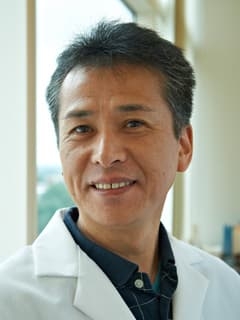
Eiki Koyama, DDS, PhD
About Eiki Koyama, DDS, PhD
I have been a biomedical researcher for more than 20 years and currently am a faculty member in the Translational Research Program in Pediatric Orthopedics at Children's Hospital of Philadelphia (CHOP). My research interest involves early limb patterning, craniofacial development and synovial joint formation.
In the early 1990s, my colleagues and I studied the roles of retinoic acid (RA) in early limb development. At that time, RA was thought to be one of the strong candidates of morphogen, which can determine the anteroposterior axis of developing limb buds. We have tackled this notion and found that RA is unlikely a morphogen, but it acts as an inducer of the morphogen to control the limb patterning. This notion has been widely accepted and has lead to the finding of the real morphogen, Hedgehog, which can be induced by RA.
I've started to study the mechanisms of synovial joint. At prospective joint sites, the first overt sign of joint development is the appearance of a layer of closely-packed mesenchymal non-chondrogenic cells referred to as interzone. The cells have been thought to be very important for joint formation, but its real function was obscure at that time. To tackle this key issue, my team and I carried out genetic cell tagging and tracking studies. We found that interzone cells gave rise to most of all joint tissues, including articular cartilage layers, synovial lining, inner capsule and intra-joint ligaments and clarified at the molecular level the interzone cells represent a specialized cohort of progenitor cells exclusively determined for joint formation. This study has shed light on the mechanisms of synovial joint formation and the work has been highly quoted by other biomedical researchers.
Currently I am focusing on several congenital conditions including Hereditary Multiple Exostoses (HME) that affects children and young adults. Based on our extensive knowledge of the normal processes of skeletal development and growth, I would like to clarify the molecular mechanisms of HME formation and growth. We hypothesized that the Heparan sulfate deficiency in HME causes mis-distribution and mis-expression of potent growth factors, such as Hedgehog protein and other pro-chondrogenic factors and enhances the responsiveness of perichondrial cells to these and other local factor. To verify this hypothesis, we have currently exploited a number of mouse models for HME. We expect that these powerful and unique models will also allow us to test possible rational pharmacologic therapies based on those insights.
Titles
Faculty, Biomedical Research Program in Pediatric Orthopaedics
Research Interests
Early limb patterning Craniofacial development Synovial joint formation
Education & training
Graduate Degree
PhD, Developmental Biology — Okayama University, Okayama, Japan (1992)
Medical Degree
DDS — Matsumoto Dental University, Shiojiri, Nagano, Japan (1985)